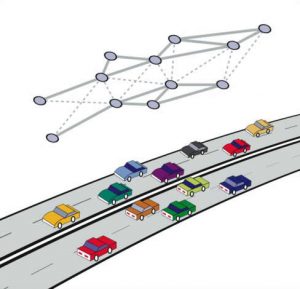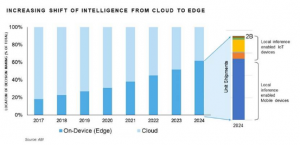One of the exciting application areas of wireless ad hoc networks is the automobile sector. Ad hoc network technology will be used in the near future in the car’s onboard communication unit in order to collect real-time data on traffic and road conditions from a variety of onboard sensors. Areas of application include services like safety warning systems, traffic control, and real-time traffic re-routing by intelligent traffic management systems.
 Recently the FCC’s has allocated the 5.85-5.925GHz portion of the spectrum for inter-vehicle communications (IVC) and vehicle-to-roadside communications (VRC), known as Dedicated Short Range Communications (DSRC). This is fueled significant interest in designing new applications, including driver-vehicle safety applications, infotainment, and mobile internet services for passengers. In addition to low cost and robust wireless communication devices, vehicles can also be equipped with storage, processing, and sensing capability. There is a huge untapped opportunity to leverage such vehicular-based ad hoc networks (VANETs) to enable a wide variety of new services and societal applications. In particular, VANETs can be used to provide/implement the following networking, computing, and sensing primitives:
Recently the FCC’s has allocated the 5.85-5.925GHz portion of the spectrum for inter-vehicle communications (IVC) and vehicle-to-roadside communications (VRC), known as Dedicated Short Range Communications (DSRC). This is fueled significant interest in designing new applications, including driver-vehicle safety applications, infotainment, and mobile internet services for passengers. In addition to low cost and robust wireless communication devices, vehicles can also be equipped with storage, processing, and sensing capability. There is a huge untapped opportunity to leverage such vehicular-based ad hoc networks (VANETs) to enable a wide variety of new services and societal applications. In particular, VANETs can be used to provide/implement the following networking, computing, and sensing primitives:
- First, using local storage, each vehicle can act as a swarm mobile router and an ad hoc network of vehicles can form an intelligent transit network.
- Second, using the local processing capability, an ad hoc network of vehicles can form an on-demand and dynamic grid computing engine.
- Third, with the sensing capability, the vehicles all together can function as a distributed mobile sensor network.
Vehicular ad hoc networks (VANET) are created by vehicles equipped with short and medium range wireless communication technology Communication is possible between vehicles within each other’s radio range, and with fixed gateways along the road. These type of networks will be used in the future to collect real-time data on road conditions and traffic from a variety of onboard sensors. Some of the important applications of the resulting sensor networks are safety applications including col lision and other safety warning systems driver assistant and information systems and, further down the road, intelligent traffic management systems. Such systems will feed sensor data collected from vehicles and roadside sensors into traffic analysis and simulation soft-ware and use the result for control and management of traffic on the fly. The opportunities for VANET are growing rapidly with many vehicle manufacturers and their suppliers actively supporting research and development in this area. In the US, the FCC approved 75 MHz of spectrum for inter-vehicle communications (IVC) and vehicle-to-roadside communication (VRC), known as Dedicated Short Range Communication (DSRC).
Creating high-speed, highly scalable and secure vehicular sensor networks presents an extraordinary challenge due to a combination of highly dynamic mobility patterns, which result in highly dynamic network topologies, combined with the high velocities that can be involved. On the other hand, certain limitations commonly assumed in other ad hoc sensor networks are not resent in these systems. For example, vehicular sensor networks have access to ample computational and power resources within the network itself, and can utilize high-performance wireless communication and advanced antenna technology. Finally, it can be expected that a significant fraction of vehicles will have an accurate knowledge of their own geographical position, by means of GPS.
Sensors in cars can provide information on both instantaneous and time-averaged speed of the car as well as its position. The position information can be obtained either directly using onboard GPS capability, if this is available, or based on information received from neighboring vehicles which have GPS. The sensors can also provide information on local traffic density and instantaneous front and back headways. These sensors can form a network on top of the VANET communication structure. Broadly speaking proposed applications that are designed to benefit from such vehicular sensor networks can be classified into safety applications and traffic monitoring and management systems. These applications exploit the exchange of sensor data between the cars themselves. One example is emergency breaking. In case of an accident or if the brakes are pressed hard or floored, a notification is sent to following cars. Information of accidents can even be transported by cars driving in the opposite direction and, in this way, be conveyed to vehicles that might run into the accident. Other possible safety applications include passing assistance, security distance warning, and coordination of cars.
Bluetronix feels confident that its Swarm Routing will provide a solution for VANETs based on its capability to scale, work with mobility, and adapt very quickly to changing conditions.



